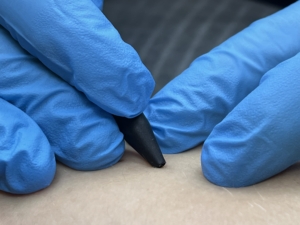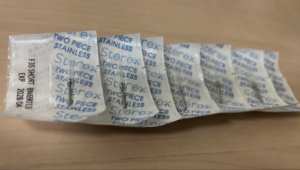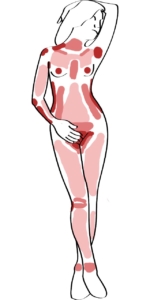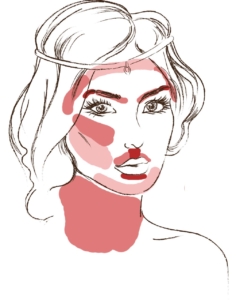Electrolysis hair removal
Electrolysis hair removal method was developed in 1875. Dr. Charles Michel was an ophthalmologist and an army field surgeon during the American Civil War, and it was thanks to him that the electrolysis journey began to develop.
By the 19th century, doctors had determined that hair grows from the bulb located at the base of the hair follicle, and this is where growth must be limited.
In the 20th century, electric epilation began to be used more and more and the procedure became more popular.
Today, electrolysis is used all over the body to remove troublesome hair.
A very fine needle is inserted into the natural opening of the hair follicle alongside the hair shaft and up to the hair root. Electrical energy comes from the needle, which weakens and eventually kills the hair root, afterwards he hair is removed with tweezers. Each hair is treated individually.
Electrolysis method can remove dark hairs, light hairs and also reddish hairs. Both softer and weaker as well as strong and coarse.
Before the electrolysis procedure
The hairs must have grown to a length that can be grasped with tweezers, about 2 mm.
The skin can be peeled the day before the procedure. We suggest applying moisturizing lotion to the skin the day before the procedure.
The skin must be healthy before the procedure and should be makeup-free.
If you want to remove hair from a birthmark, be sure to have a dermatologist examine the birthmark first to make sure everything is fine.
Between electrolysis procedures
Between electrolysis procedures, hair should only be removed by shaving or cutting.
Removing hair by plucking, waxing, sugaring or using an epilator works against the results of electric epilation.
After the electrolysis procedure
After the procedure, the skin may be red and swollen, crusts or bumps may appear.
Aloe Vera gel can be used at home to help the skin recover.
We recommend using zinc ointment in case of blisters and crusts.
After the procedure, drink more water than usual, water helps the skin recover.
Omega 3 fish oil also helps the skin to recover.
It is important to protect the skin from water, sun and sweat for at least 24 hours, depending on the sensitivity of the skin. After being treated with the Thermolysis method, the recommended time would be even 48 hours.
NB! 24h-48h is the recommended time. In the case of greater skin irritation, you should care for the skin longer. During the period when the sun is more active, it is worth keeping the skin away from direct sunlight for 3-7 days and using a cream with an SPF50 protection factor in the area of the procedure to avoid hyperpigmentation. You should also avoid travelling to an area with a lot of exposure to sunlight.
NB! The results of electrolysis hair removal are individual.
We are all different, and so is our hair growth and hair strength. Hair growth depends on many different factors, including hormonal factors – for example, people with hormonal problems may take longer to achieve optimal results than others.
In any case, regular procedures are extremely important, in the beginning more rather than less, and over time the number and frequency of procedures will decrease.
Contraindications for electrolysis hair removal
The main contraindications for electrolysis hair removal are:
- pacemaker;
- metal implants in the body;
- epilepsy;
- blood clotting disorders;
- cardiovascular diseases;
- recent major operations;
- HIV/AIDS;
- Hepatitis B;
- Hepatitis C;
- skin diseases/disorders in the procedure area;
- scar tissue in the procedure area;
- pregnancy;
The procedure is not recommended during breastfeeding.
Areas of the body where the electrolysis hair removal procedure is performed
Electric epilation can be performed in almost any area of the body – including the nose, ears, etc.
The most common areas for hair removal are the face (including eyebrows, upper lip, lower lip, chin), armpits, hairline, neck, chest (including nipples), stomach, bikini line, legs (including toes), hands, back.
Some areas of the body, just like people, are much more sensitive to pain than others, for example the upper lip area, so the possibility of the procedure in the desired area of the body also depends on Your pain threshold.
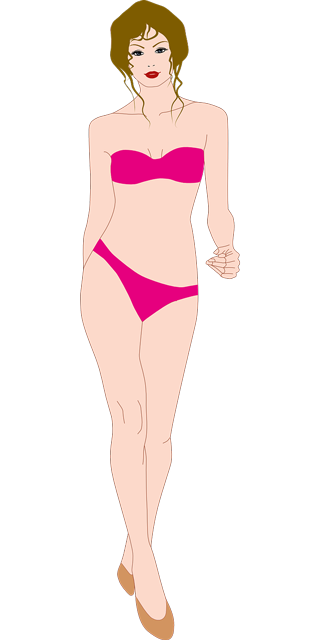
Electrolysis methods
Thermolysis Method
Thermal method of hair removal.
Time to remove 1 hair: 2 seconds.
Pros: the procedure is faster and larger area can be covered.
Cons: Hair with curved follicles is more difficult to remove. Not so skin friendly.More painful procedure.
Blend method
A chemical reaction occurs, lye is formed.
Time to remove 1 hair: 5-10 seconds.
Pros: Hair with curved follicles is easier to remove. Much more skin-friendly and less painful.
Disadvantages: the procedure is slower and smaller area can be covered.
NB: there must not be any metal implants in the body !!!
Electrolysis pain threshold pain chart
NB! Each person has a different pain threshold, so the pain charts below may not exactly match Your pain threshold.
- Light pink – low pain
- Pink – medium pain
- Red – severe pain
Comparison guide of different hair removal methods
| Procedure | Electrolysis | Laser | Waxing / sugaring | Shaving | Depilatories | Tweezing / threading | Home Epilators |
|---|---|---|---|---|---|---|---|
| Permanent | Yes | No Laser provides hair reduction, not permanent hair removal. | No | No | No | No This method also can significantly interfere with the effectiveness of other hair removal methods. | No |
| Areas of the body | All | Not recommended for eyebrows. | Not suitable for some sensitive areas of the body; sugaring especially may not be a good choice for nipples or genitals. | Not suitable for some sensitive areas of the body. | Not suitable around the eyes, and other sensitive areas of the body. | Face and unwanted individual hairs; not suitable for large areas of hair removal. | Face and unwanted individual hairs; not suitable for large areas of hair removal. |
| Skin / hair types | All | Most effective for those with dark hair and light skin. Less effective for dark skinned/dark haired individuals or those with light-colored hair. | All | All | All | All | All |
| Special Conditions | All | All | Not suitable for people with diabetes or circulatory problems. | All | Not suitable for chemically sensitive skin. | Not recommended for hormonally induced hairs. | All |
| Comfort | Varies by client sensitivity. Comfort can be increased through relaxation, hydration, adjustments to treatment settings, topical anesthetics, and other methods. | Can be painful; mild to significant irritation and skin discoloration is possible. | Significant pain, especially in sensitive areas. | Relatively painless low-cost option, but may cause skin irritation. | Painless but may cause irritation; strong chemical odor. | Can be painful and time-consuming.. | May cause mild to moderate discomfort. |

